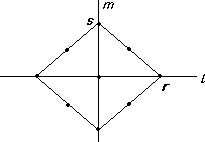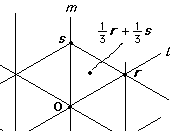 If n = 2 (so that l and m are perpendicular) then we can argue as in Stage 2 above:
If n = 2 (so that l and m are perpendicular) then we can argue as in Stage 2 above:
If 1/2 R + 1/2 s ∈ L then both R1 and R2 give the cm situation (i) above and we get the group cmm.
If R and s form a basis for the lattice L then we get three possibilities.
- The shift vectors of R1 and R2 are both 0 and we get the group pmm
- The shift vectors of R1 and R2 are both non-0 and we get the group pgg
- The shift vectors of R1 is 0 and that of R2 is non-0 and we get the group pmg
 If n = 3 then the axes of reflection l and m are at 120° or 2π/3.
If n = 3 then the axes of reflection l and m are at 120° or 2π/3.Choose R and s as shown.
In this case all the shift vectors will be 0.
We get one of the following cases
- The point 1/3 R + 1/3 s ∈ L
In this case, the some of the centres of 3-fold rotation are not on reflective axes.
The group is called p31m
- The vectors R and s are a basis for the lattice.
In this case, the some of the centres of 3-fold rotation are all on reflective axes.
The group is called p3m1
- Both shift vectors are 0 ⇒ group is p4m (it should really be called p4mm)
- One shift vector is 0 and one is not ⇒ group is p4g (it should really be called p4mg)